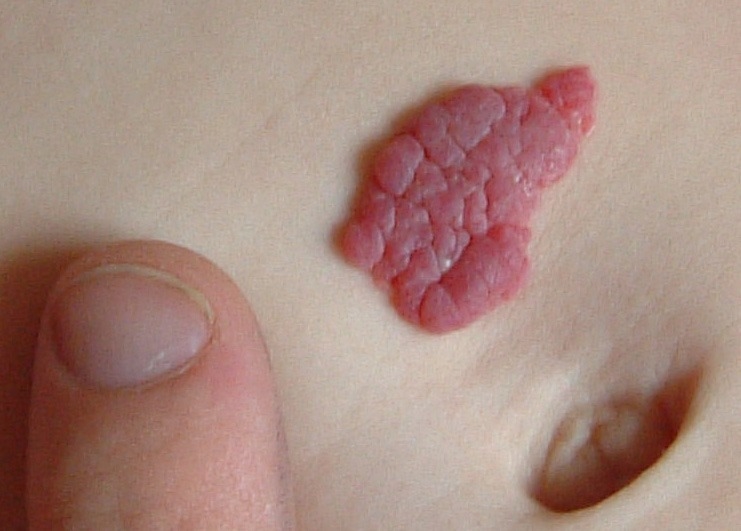
Infantile Hemangioma: A Birthmark Or A Tumor?
27 Dec 2017 | 4 min Read
Babychakra
Author | 1369 Articles
What is infantile hemangioma?
Infantile hemangioma or strawberry mark is the commonest birthmark, which usually appears as a rubbery bright red nodule made up of extra blood vessels of the skin. It grows during the first 6 months of life and fades away over a period of time. It may occur anywhere in the body, and it does not require any treatment. Cherry mark is another type of infantile hemangioma birthmark of a blood vessel. It is nothing but a small benign collection of the blood vessels. It appears when cells of the blood vessels multiply near the surface of the skin. It is generally seen as a bruise or a tiny red bump.
Where and when do these hemangiomas appear?
Infantile hemangiomas commonly appear on the skin surface of the scalp, face and neck. Occasionally, they appear on the abdomen of the baby. Rarely, do they develop inside an organ like the liver.
These hemangiomas usually appear during the first 4-6 weeks of life. Most of the skin hemangiomas appear before 6 months of age. However, some may not be visible right at birth and develop in the weeks after being born.
How common are hemangiomas?
Hemangiomas are very common. Around 10% infants are born with at least one hemangioma. They are more common in girls and are seen more frequently in Caucasian infants. They are rarely seen in Asian or Indian infants. Premature babies have more chances of developing hemangiomas.
Is an infantile hemangioma dangerous?
Most of the infantile hemangiomas are harmless and benign (self-limiting). Only few hemangiomas, which are near the eyes or in the throat may affect vision or breathing, respectively.
If your child has a hemangioma near the eyes or in and around the throat, it is safer to consult a pediatrician or a vascular anomaly specialist. In case of hemangioma in the liver or in any internal organ, it may require a regular screening for checking if it has ruptureds.

What do hemangiomas look like?
Hemangiomas occur more commonly on the skin and rarely inside an organ. General hemangioma types include superficial, deep and mixed hemangiomas. Superficial hemangiomas occur on the outer layer of the skin and are reddish purple in color. Deep hemangiomas grow under the skin or fat tissue, and they appear purplish blue. Mixed hemangiomas have both these variants, and they are the most common ones.

Will my baby’s hemangioma grow?
Usually, hemangiomas are benign, which means they don’t grow in size. However, infantile hemangiomas grow quickly in the first few weeks and start shrinking once the baby is a year old. Apart from shrinking, their colour may also start fading or they may turn grey. It can take several years for hemangiomas to completely disappear. If your baby has a larger hemangioma, it may take a longer time, and it may also leave behind a scar. These aspects differ based on the type of hemangioma your baby has, so it is best to consult your pediatrician to understand exact details for your baby.
Can hemangiomas harm my baby?
Most hemangiomas grow and then shrink without troubling the child. However, complications can occur, such as follows:
- It can result in a wound or a scab
- If a hemangioma is near the eyes or the neck, it can hamper vision and breathing, respectively.
- A facial hemangioma can look ugly
- Hemangioma of the internal organ can bleed and cause organ failure
How can hemangiomas be removed or treated?
Usually, hemangiomas don’t require any treatment as they tend to fade away or shrink spontaneously. However, if they cause complications or are disfiguring, they can be removed by giving oral steroidal therapy, surgical treatment, laser therapy or by using medicines like vincristine and becaplermin gel.
Can hemangiomas recur after shrinking?
No, once shrunk, hemangiomas never reappear.
Disclaimer: The information in the article is not intended or implied to be a substitute for professional medical advice, diagnosis or treatment. Always seek the advice of your doctor.
Also read: Different Types of Birthmarks
Explore the entire collection of articles: Baby Care
A


Related Topics for you
Suggestions offered by doctors on BabyChakra are of advisory nature i.e., for educational and informational purposes only. Content posted on, created for, or compiled by BabyChakra is not intended or designed to replace your doctor's independent judgment about any symptom, condition, or the appropriateness or risks of a procedure or treatment for a given person.
